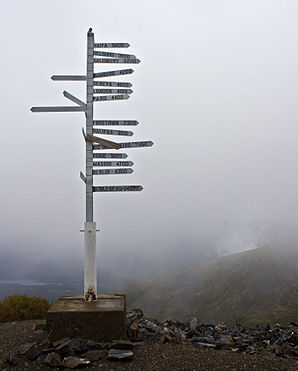Keno City
| Keno City | ||
|---|---|---|
 Keno City Mining Museum |
||
| Location in Yukon | ||
|
|
||
| State : |
|
|
| Territory : | Yukon | |
| Coordinates : | 63 ° 55 ′ N , 135 ° 18 ′ W | |
| Residents : | 15 (as of 2006) | |
 Signpost on Keno Hill |
||
Keno City is a very small community in the Yukon Territory at the end of the Silver Trail Highway .
Keno City was named after the game of chance Keno , which was very popular in the mining camps towards the end of the 20th century. The population was exactly 15. It is about 14 kilometers away from Elsa , which is now a ghost town.
In 1919 John August Komman found silver on Lightning Creek , in the same year Louis Bouvette found silver and lead (in the form of galena ) on Keno Hill . Komman had come north with the Klondike gold rush in 1898 and had filed claims in 1908 and 1909 in what would later be Keno. The timbers of log houses on Duncan Creek were taken apart and rebuilt in keno. In 1920 the place already had a hotel, the Keno City Hotel , which reopened in 1963 and operated until the mine was closed in 1989. The Keno City Café was also created, which became a restaurant in 1949. In 1922 Territorial Agent Victor Grant built a cabin, the Grant Cabin . Frank White, whose hut has also been preserved, worked on the development of the SS Keno paddle steamer , which is now in Dawson . It was flat enough to be able to drive on the Stewart River and thus connect Keno to traffic. The hut of Ernest Joseph Corp, who represented the Mayo district in the Yukon Council from 1934 to 1939, is also preserved.
In 1922, 12,000 tons of silver ore were transported to Mayo . Between 1945 and 1989, the nearby Elsa mine produced 150 million ounces of silver, 490 million pounds of lead and 370 million pounds of zinc. It was the largest silver mine in Canada.
In 1923 a station for the Royal Canadian Mounted Police (detachment) was established in the village , but in 1937 it was only a sub-detachment. The building had two cells.
Around 1950 some prostitutes from Dawson came to Keno, including Margaret Vera Dorval, known as "Bombay Peggy", who ran her business in the Tolmie Cabin. As early as the 1940s, Anne Janice ("Alteration Anne"), who came from Whitehorse , earned her money in the same business. Caroline “Ma” Ericsson ran a so-called boarding house in which she rented out individual rooms. She supplied the miners with food.
From 1954, the Anglican Church owned the All Saints Anglican Church . As early as 1949, Henk Huijbers, a man from the Dutch resistance against the German occupation - he received an award from the Dutch parliament in 1982 - came to Keno, who led the Catholic Church. However, this was sold in the late 1970s.
Few artists, miners and retirees live in Keno City today.
Tourist attractions here are the Keno Mining Museum and the signpost, which is located on the top of Keno Hill. The museum shows the history of mining on the Silver Trail through a wide collection of historical items.

